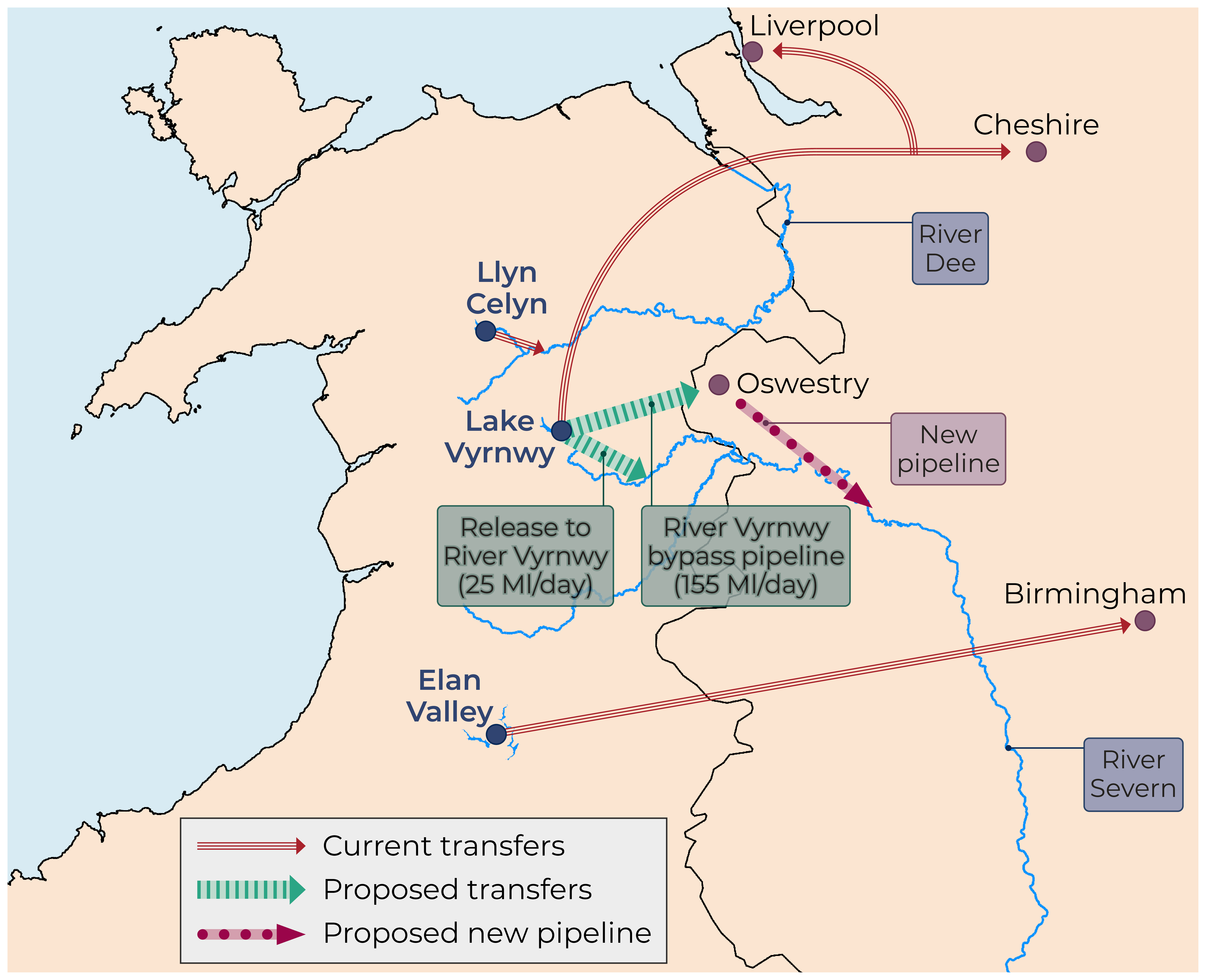Water in Wales continues to make headlines. This time it’s not the quality of water in our rivers, but how much there is for supply and, importantly, where it’s going.
Pressures from climate change, population increases, and the need to conserve natural aquatic environments are all increasing the demand for water. Last year’s Wales-wide drought highlighted our reliance on a sufficient supply of water.
Water companies are responsible for meeting the needs of customers in the area that they supply, but are increasingly working together to create resilient water solutions. One potential solution is to transfer water from areas where there’s a surplus of water, to areas where there’s a shortfall.
One proposal in the pipeline is to transfer water from Lake Vyrnwy in Powys to the Thames basin, boosting supply in London and south east England.
Water being transferred from Wales to England isn’t new, but it has a contentious history. In 1965 the Tryweryn Valley, including the village of Capel Celyn, was flooded to create a reservoir to supply Liverpool with water. It has been described as “a shameful chapter in Welsh history", which ignited a new wave of Welsh language campaigns, and calls for devolution. Liverpool council apologised in 2005, but the subject continues to stir up strong emotions in Wales.
This article looks at how much water is currently being sent over the border, and what’s being proposed.
How much water is being transferred out?
There are two main water companies serving customers in Wales, Dŵr Cymru and Hafren Dyfrdwy (created by the merger of Dee Valley Water and the Welsh part of Severn Trent Water). Two further companies, Severn Trent Water and United Utilities, border Wales and hold licences to take water from Wales to serve customers in England.
Dŵr Cymru operates a series of connected reservoirs in the Elan Valley. From this area, the Elan Valley bulk supply is an export of more than 320 Million litres (Ml) per day, via the 117km long Elan Aqueduct, to Severn Trent Water for it to supply its customers in Birmingham.
To put these quantities into context, an Olympic swimming pool holds 2.5 Million litres of water, so the Elan Valley bulk supply is 128 Olympic swimming pools worth of water being exported each day.
United Utilities is reportedly licenced to take take 252 Ml/day from Lake Vyrnwy (around 100 Olympic swimming pools), which is mostly used to supply customers in Liverpool and Cheshire, but can be pumped to Manchester if needed.
Llyn Celyn was constructed to maintain flows in the River Dee as part of the Dee Regulation Scheme. This regulation means that water companies are able to abstract water downstream, which includes an abstraction by United Utilities to supply Liverpool. From various abstraction points, its reported that United Utilities can take a total of – that’s almost 250 Olympic swimming pools of water
These reported quantities of water are the maximum licenced. The amount actually traded varies each year, alongside the charge for the traded water.

© Crown copyright and database rights 2023 OS 100047295.
An idea in the pipeline
It’s been proposed that water is transferred from the River Severn to the River Thames, the ‘Severn to Thames Transfer’ (STT), where it can be abstracted by Thames Water, and potentially other companies in south east England.
This is being progressed collaboratively by Severn Trent Water, United Utilities Water and Thames Water through the Regulators’ Alliance for Progressing Infrastructure Development (RAPID), with input from the regulators: Ofwat, the Environment Agency and the Drinking Water Inspectorate.
The ‘North West Transfer’ is the United Utilities element of the STT, which involves redirecting up to 180 Ml/d of water (currently licenced to United Utilities) from Lake Vyrnwy into the River Severn. This is to be transferred using two separate means:
- a direct release of 25 Ml/d of water into the River Vyrnwy; and
- a release of 155 Ml/d of water into the existing Vyrnwy Aqueduct to Oswestry, where a new ‘Vyrnwy bypass pipeline’ will transfer the water into the River Severn.
The maximum release allowed from Lake Vyrnwy is 405 Ml/d. The proposed release direct from Lake Vyrnwy falls within this limit. There are no works proposed in Wales and no change in the quantity of water currently abstracted by United Utilities. Because of this, Natural Resources Wales (NRW) is involved in an advisory capacity only. However RAPID works closely with the Welsh Government and NRW where any potential schemes may be within or affect Wales.
Bulk transfer arrangements can either be continuous; moving water from an area with an abundance to one with limited resources, or temporary, providing extra resources in times of drought if available. As such, bulk transfers are included in water companies’ statutory long term Water Resources Management Plans (WRMPs), and short term Drought Management Plans.
Before any final decision is made on the STT, final WRMPs for each company will all have to be agreed, which will be around October 2023. The water transfer plans will then be agreed later.
A dam sight more
It’s important to highlight that reservoirs are not only used for water supply, but are complex multi-use sites, important for nature and recreation. Most reservoirs in Wales, and their surrounding areas, are protected for their internationally important ecosystems and landscapes.
Lake Vyrnwy is as designated as it gets - a National Nature Reserve, a Site of Special Scientific Interest, a Special Protection Area, and a Special Area of Conservation. It’s even home to the largest organic farm in Wales.
There are productive hydropower schemes on a number of dams, including at the Elan Valley and Llyn Celyn. Downstream of the dam at Llyn Celyn the River Tryweryn is used by the National White Water Centre during water releases, often enabling white water sports to take place during the summer.
The needs of nature and communities have to be considered before any proposal to move or utilise a water source is approved. As recently highlighted by the Minister for Climate Change, Julie James:
Any development that involves sourcing water from Wales must demonstrate economic, environmental and wider benefits for the people of Wales.
Dŵr Cymru recently told a House of Lords Committee that it would support water transfers as long as sufficient criteria were met, including no detriment to customers or the environment, and “to make absolutely certain that the commercial rate for that transfer was appropriate”.
Article by Lorna Scurlock, Senedd Research, Welsh Parliament






